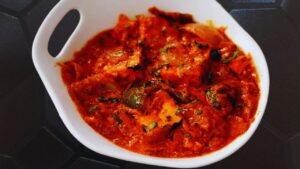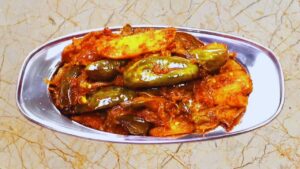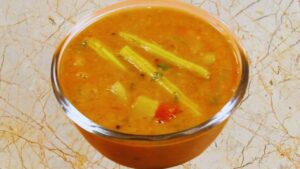Sarson ka saag is actually made with a paste of mustard, palak, and bathua greens cooked along with onion, ginger, garlic, and a variety of spices in ghee. It is then tempered further with ghee, onion, ginger, garlic, and butter. The process to make sarson ka saag at home is quite simple, as described in my recipe.

KEY TAKEAWAYS
- Sarson ka saag is a popular dish of North India, especially in the winter season.
- Enjoy it with its traditional accompaniment, makki ki roti.
- Sarson ka saag tastes earthy, creamy, and slightly spicy.
- Other similar recipes are palak saag, methi saag, and bathua saag.
The Ingredients:
For making the saag:
- 500 grams sarson ka saag (washed, roughly chopped)
- 250 grams palak (washed, roughly chopped)
- 250 grams bathua saag (washed, roughly chopped)
- 100 grams radish (washed and cut into small pieces)
- 4 pieces garlic (whole, deskinned)
- 1 piece onion (small size, roughly diced)
- 1 tsp salt
- 1 cup water
- 2 tbsp ghee (clarified butter)
- ½ tsp asafetida (hing)
- ½ tsp cumin seeds (jeera)
- 3 pieces green chilies (finely chopped)
- 1 tbsp ginger (paste or grated)
- 1 tbsp garlic (finely chopped)
- 1 cup onion (finely chopped)
- 1 cup tomato (finely chopped)
- ½ tsp turmeric powder
- ½ tsp red chili powder
- 1 tsp coriander powder
- ½ tsp cumin seeds powder
- 2 pieces butter cubes
For making the tadka:
- 2 tbsp ghee
- 1 tbsp onion (finely sliced)
- 1 tbsp garlic (julienne)
- 1 tbsp ginger (julienne)
- 1 piece butter cube

I got this recipe from the woman who owns and runs a small stationery shop in our locality. I had gone to buy chart paper one afternoon and noticed her eating lunch quietly. The flavor of the food filled the entire place. I asked her what she was eating, and she smiled in reply and asked me to have a bite while sharing the recipe gladly with me.
I tried it at home that week. My husband said it felt thoughtful, and the boys enjoyed the new addition. Now, it is our back-to-school meal. That moment reminded me that every small business woman carries not just stock but stories and meals that fill both belly and heart, paper by paper, bite by bite.
How to Make Sarson ka Saag? (Step by Step Guide with Images)
Step 1: Take 500 grams of sarson ka saag, 250 grams of palak, and 250 grams of bathua saag. Wash them nicely and chop them roughly. Put them all in a pressure cooker. Also, add 100 grams of radish (washed and cut into small pieces), 4 pieces of garlic (whole, deskinned), 1 piece of onion (small size, roughly diced), 1 tsp of salt, and 1 cup of water. Close the lid of the pressure cooker and cook them for up to 3 whistles.

(Pro tip: Never cook only sarson ka saag. Adding palak and bathua adds to the rich taste).
Step 2: When done, switch off the flame of your gas stove for the pressure to release and open the lid. Mix everything nicely.

Step 3: Transfer the saag to a blender. Blend it to a smooth paste.

(Pro tip: Do not discard the water. Keep it aside. It will be used later).
Step 4: Now, heat 2 tbsp of ghee (clarified butter) in a kadai. When it melts and is hot, add ½ tsp of asafetida (hing), ½ tsp of cumin seeds (jeera), 3 pieces of green chilies (finely chopped), 1 tbsp of ginger (paste or grated), and 1 tbsp of garlic (finely chopped). Stir and fry them all nicely.

(Pro tip: Always add ginger, either grated or as a paste; otherwise, the pieces of chopped ginger will spoil the taste of the saag).
Step 5: Then, add 1 cup of finely chopped onions to it. Stir and fry them all for another 3 to 4 minutes until the onions turn golden brown.

Step 6: Now, add 1 cup of finely chopped tomatoes. Turn the flame of the gas stove to low and stir it continuously until the tomatoes turn soft and blend nicely with the other ingredients.

(Pro tip: If the tomatoes or onions stick to the bottom of the kadai, add a teaspoon of ghee or oil and continue cooking them).
Step 7: When the tomatoes and onions are cooked nicely, add ½ tsp of turmeric powder, ½ tsp of red chili powder, 1 tsp of coriander powder, and ½ tsp of cumin seed powder. Mix and cook them all nicely for another minute or so.

Step 8: When the spices are fried nicely and you can smell the aroma, add the water you had kept aside in the pressure cooker. Mix it and let it come to a boil. When it does, add the blended saag along with salt to taste.

(Pro tip: Do not add too much salt, as it was also added while boiling the saag).
Step 9: Mix them nicely. Use a wooden churner (dal ghotni) for additional smoothness. Cover the kadai and let the saag cook for 8 to 10 minutes on a low flame; the more it is, the better the taste will be.
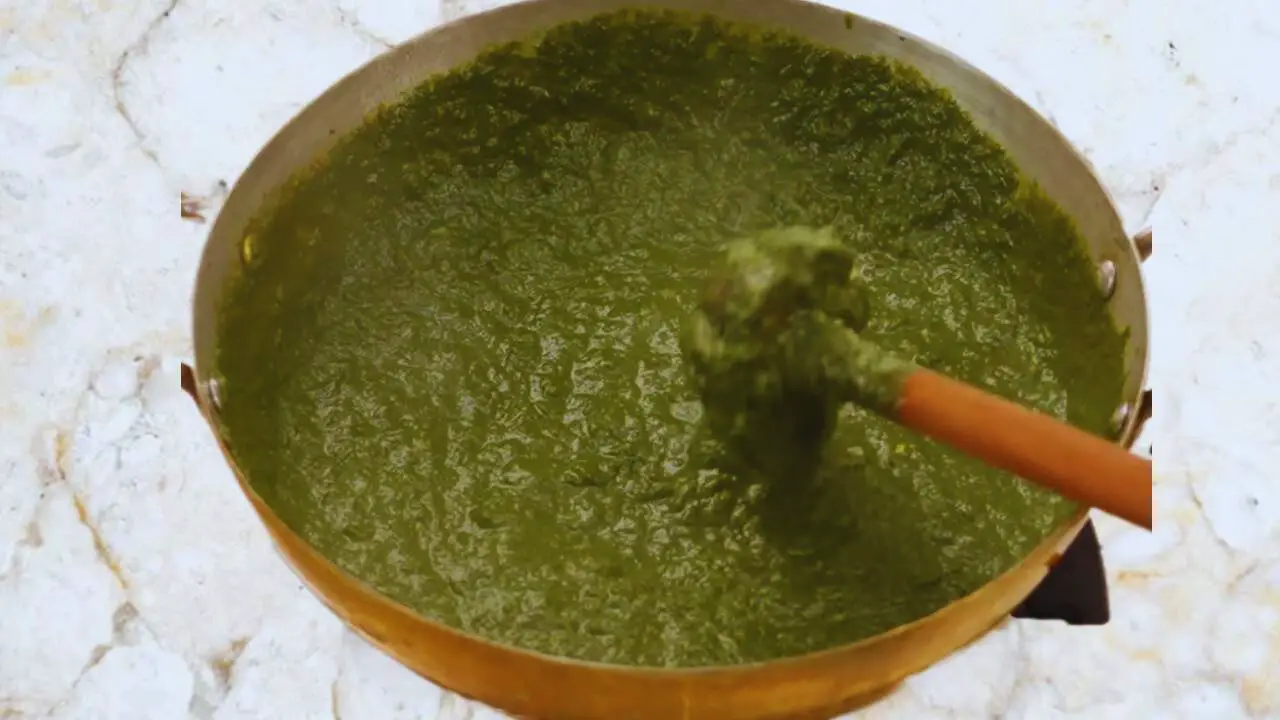
Step 10: Check the texture of the saag now. If it is too free-flowing, add two tablespoons of makki ka atta for binding. Mix, cover, and cook it for another couple of minutes so that the raw taste of the atta is gone.

(Pro tip: If you do not have Makki ka atta, you can use besan or gram flour in its place after dry roasting them a bit as an alternative).
Step 11: Check the texture of the saag again after two minutes, and if it is quite thick, add 2 cubes of butter. Mix it, and the sarson ka saag is good to enjoy with makki ki roti straightaway.

Step 12: For additional taste and Dhaba-style presentation, make a tadka. Take 2 tbsp of ghee, 1 tbsp of onion (finely sliced), 1 tbsp of garlic (julienne), and 1 tbsp of ginger (julienne) in a tadka pan.
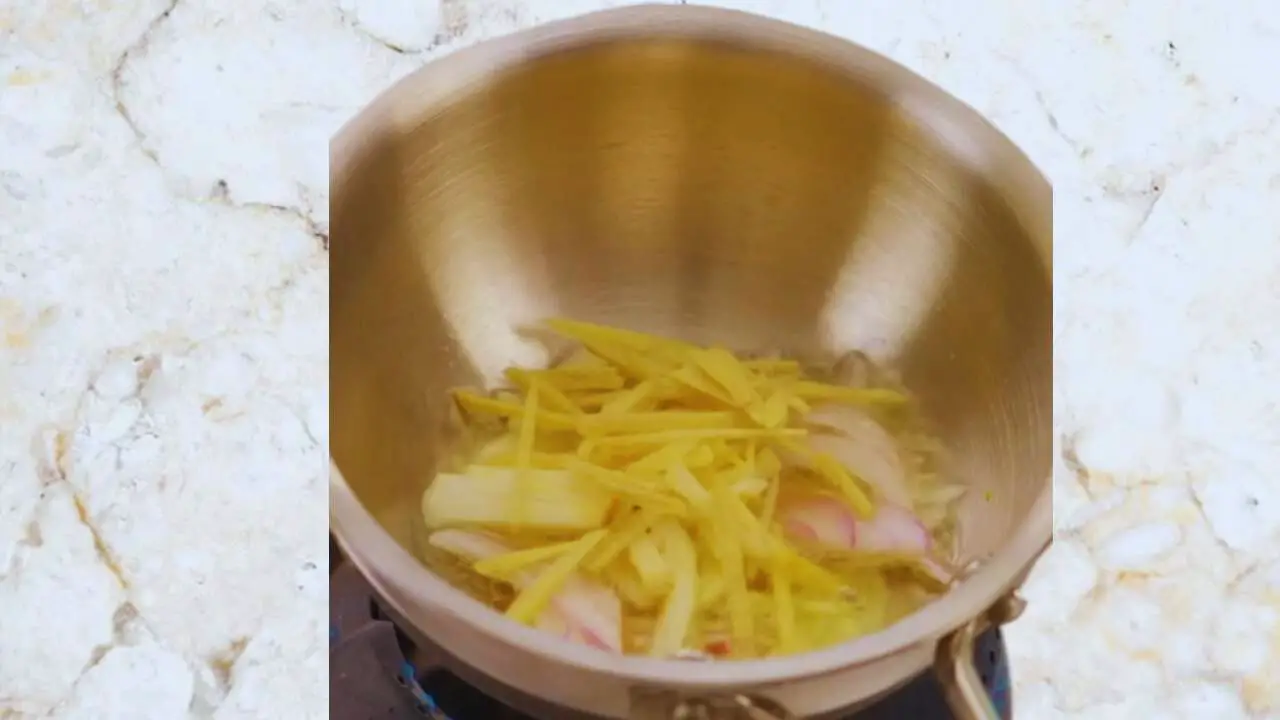
Step 13: Fry them till they turn golden brown and pour them immediately on the saag before final plating along with a cube of butter. Your delicious homemade sarson ka saag is finally ready to be enjoyed with hot makki ki roti alongside onion salad, achar, radish pieces, and green chili.

Recipe Card

Sarson Ka Saag
Ingredients
For making the saag:
- 500 grams sarson ka saag washed, roughly chopped
- 250 grams palak washed, roughly chopped
- 250 grams bathua saag washed, roughly chopped
- 100 grams radish washed and cut into small pieces
- 4 pieces garlic whole, deskinned
- 1 piece onion small size, roughly diced
- 1 tsp salt
- 1 cup water
- 2 tbsp ghee clarified butter
- ½ tsp asafetida hing
- ½ tsp cumin seeds jeera
- 3 pieces green chilies finely chopped
- 1 tbsp ginger paste or grated
- 1 tbsp garlic finely chopped
- 1 cup onion finely chopped
- 1 cup tomato finely chopped
- ½ tsp turmeric powder
- ½ tsp red chili powder
- 1 tsp coriander powder
- ½ tsp cumin seeds powder
- 2 pieces butter cubes
For making the tadka:
- 2 tbsp ghee
- 1 tbsp onion finely sliced
- 1 tbsp garlic julienne
- 1 tbsp ginger julienne
- 1 piece butter cube
Instructions
- Take 500 grams of sarson ka saag, 250 grams of palak, and 250 grams of bathua saag. Wash them nicely and chop them roughly. Put them all in a pressure cooker. Also, add 100 grams of radish (washed and cut into small pieces), 4 pieces of garlic (whole, deskinned), 1 piece of onion (small size, roughly diced), 1 tsp of salt and 1 cup of water. Close the lid of the pressure cooker and cook them for up to 3 whistles. (Pro tip: Never cook only sarson ka saag. Adding palak and bathua adds to the rich taste).
- When done, switch off the flame of your gas stove for the pressure to release and open the lid. Mix everything nicely.
- Transfer the saag to a blender. Blend it to a smooth paste. (Pro tip: Do not discard the water. Keep it aside. It will be used later).
- Now, heat 2 tbsp of ghee (clarified butter) in a kadai. When it melts and is hot, add ½ tsp of asafetida (hing), ½ tsp of cumin seeds (jeera), 3 pieces of green chilies (finely chopped), 1 tbsp of ginger (paste or grated), and 1 tbsp of garlic (finely chopped). Stir and fry them all nicely. (Pro tip: Always add ginger either grated or as a paste otherwise, the pieces of chopped ginger will spoil the taste of the saag).
- Then, add 1 cup of finely chopped onions to it. Stir and fry them all for another 3 to 4 minutes until the onions turn golden brown.
- Now, add 1 cup of finely chopped tomatoes. Turn the flame of the gas stove to low and stir it continuously until the tomatoes turn soft and blend nicely with the other ingredients. (Pro tip: If the tomatoes or onions stick to the bottom of the kadai, add a teaspoon of ghee or oil and continue cooking them).
- When the tomatoes and onions are cooked nicely, add ½ tsp of turmeric powder, ½ tsp of red chili powder, 1 tsp of coriander powder, and ½ tsp of cumin seeds powder. Mix and cook them all nicely for another minute or so.
- When the spices are fried nicely and you can smell the aroma, add the water you had kept aside in the pressure cooker. Mix it and let it come to a boil. When it does, add the blended saag along with salt to taste. (Pro tip: Do not add too much salt as it was also added while boiling the saag).
- Mix them nicely. Use a wooden churner (dal ghotni) for additional smoothness. Cover the kadai and let the saag cook for 8 to 10 minutes on a low flame, the more it is, the better the taste will be.
- Check the texture of the saag now. If it is too free flowing, add two tablespoons of make ka atta for binding. Mix, cover and cook it for another couple of minutes so that the raw taste of the atta is gone. (Pro tip: If you do not have Makki ka atta, you can use besan or gram flour in its place after dry roasting them a bit as an alternative).
- Check the texture of the saag again after two minutes and if it is quite thick, add 2 cubes of butter. Mix it and the sarson ka saag is good to enjoy with Makki ki roti straightaway.
- For additional taste and Dhaba-style presentation, make a tadka. Take 2 tbsp of ghee, 1 tbsp of onion (finely sliced), 1 tbsp of garlic (julienne), and 1 tbsp of garlic (julienne) in a tadka pan.
- Fry them till they turn golden brown and pour it immediately on the saag before final plating along with a cube of butter. Your delicious homemade sarson ka saag is finally ready to be enjoyed with hot Makki ki roti alongside onion salad, achar, radish pieces, and green chili.


